University Solar Project: Planning Execution Plan for East Timor
VerifiedAdded on 2022/09/23
|18
|3178
|15
Report
AI Summary
This report details a comprehensive project execution plan for solar projects in East Timor, focusing on the Alternative Technology Association's (ATA) Village Lighting Scheme (VLS). It provides a thorough analysis of the project's background, objectives, scope, cost, schedule, and success criteria. The report includes detailed sections on project management, risk management, contracting, project control, and quality assurance. It also addresses potential issues faced by ATA, key performance indicators (KPIs), and plans for occupational health, safety, and environmental considerations. The report emphasizes the importance of stakeholder management, procurement governance, and document control, offering a complete overview of the project's planning and execution strategies to ensure successful solar project implementation in East Timor.

Running head: PLANNING EXECUTION PLAN FOR SOLAR PROJECTS IN EAST TIMOR
Planning Execution Plan for Solar Projects in East Timor
Name of the Student
Name of the University
Author note
Planning Execution Plan for Solar Projects in East Timor
Name of the Student
Name of the University
Author note
Paraphrase This Document
Need a fresh take? Get an instant paraphrase of this document with our AI Paraphraser
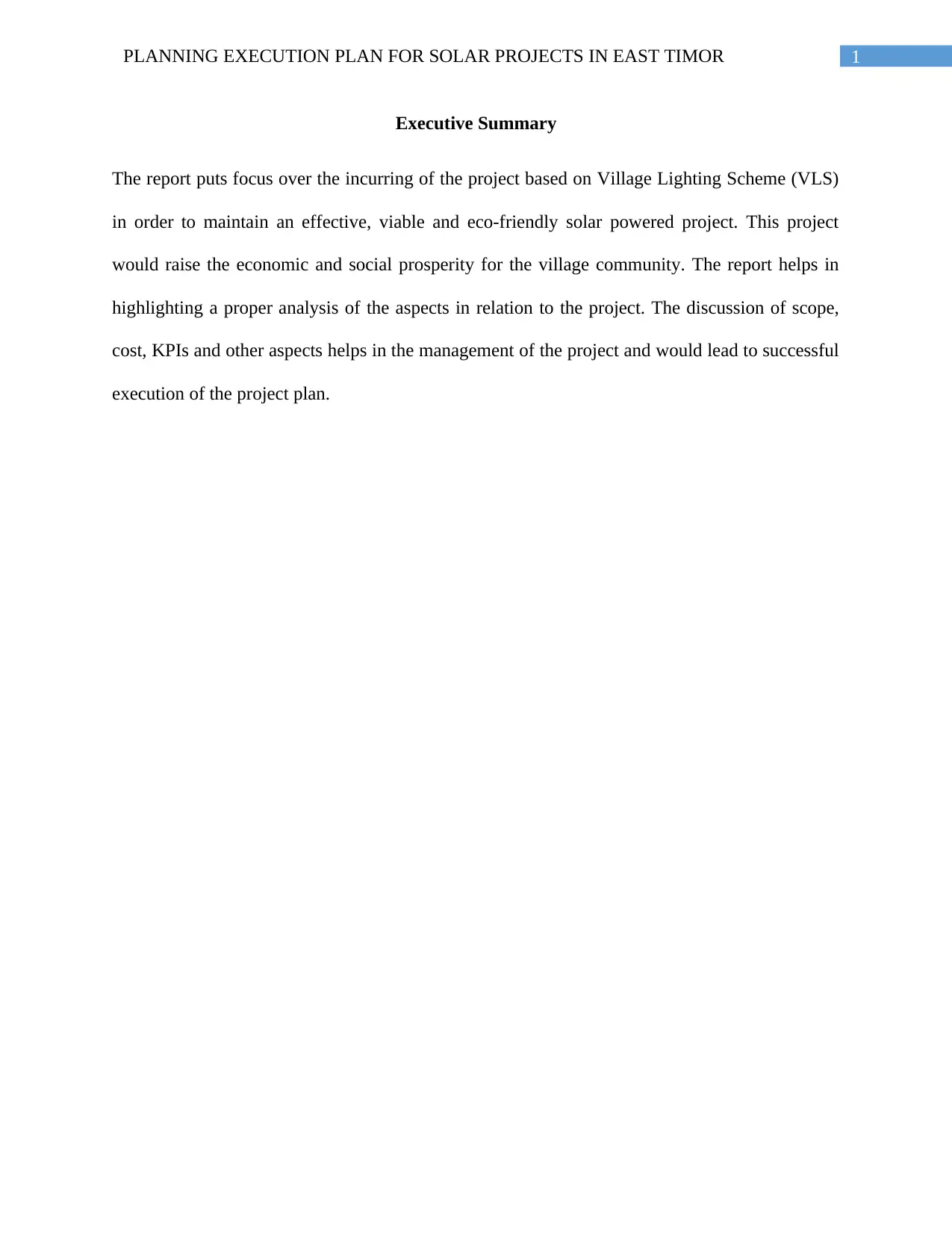
1PLANNING EXECUTION PLAN FOR SOLAR PROJECTS IN EAST TIMOR
Executive Summary
The report puts focus over the incurring of the project based on Village Lighting Scheme (VLS)
in order to maintain an effective, viable and eco-friendly solar powered project. This project
would raise the economic and social prosperity for the village community. The report helps in
highlighting a proper analysis of the aspects in relation to the project. The discussion of scope,
cost, KPIs and other aspects helps in the management of the project and would lead to successful
execution of the project plan.
Executive Summary
The report puts focus over the incurring of the project based on Village Lighting Scheme (VLS)
in order to maintain an effective, viable and eco-friendly solar powered project. This project
would raise the economic and social prosperity for the village community. The report helps in
highlighting a proper analysis of the aspects in relation to the project. The discussion of scope,
cost, KPIs and other aspects helps in the management of the project and would lead to successful
execution of the project plan.
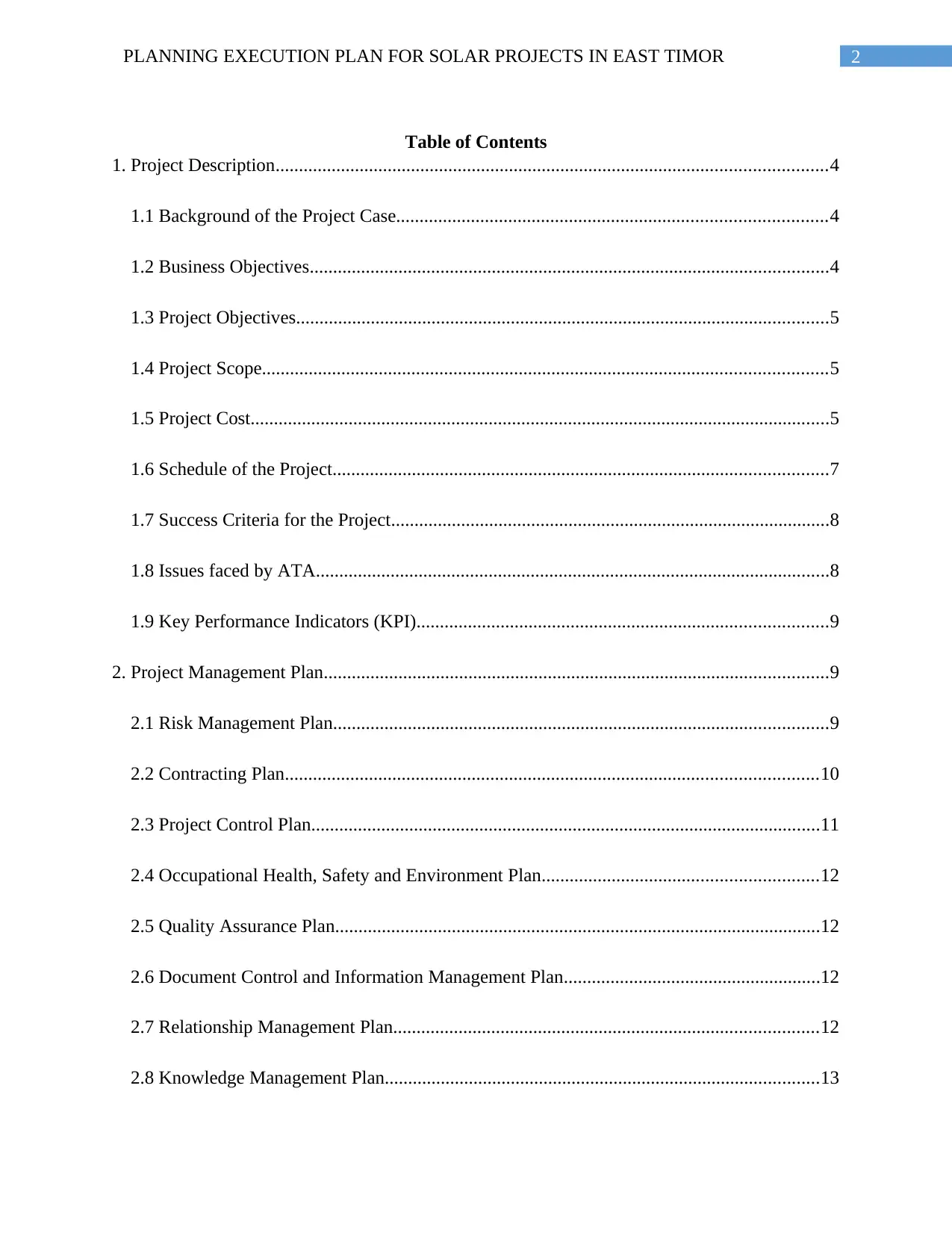
2PLANNING EXECUTION PLAN FOR SOLAR PROJECTS IN EAST TIMOR
Table of Contents
1. Project Description......................................................................................................................4
1.1 Background of the Project Case............................................................................................4
1.2 Business Objectives...............................................................................................................4
1.3 Project Objectives..................................................................................................................5
1.4 Project Scope.........................................................................................................................5
1.5 Project Cost............................................................................................................................5
1.6 Schedule of the Project..........................................................................................................7
1.7 Success Criteria for the Project..............................................................................................8
1.8 Issues faced by ATA..............................................................................................................8
1.9 Key Performance Indicators (KPI)........................................................................................9
2. Project Management Plan............................................................................................................9
2.1 Risk Management Plan..........................................................................................................9
2.2 Contracting Plan..................................................................................................................10
2.3 Project Control Plan.............................................................................................................11
2.4 Occupational Health, Safety and Environment Plan...........................................................12
2.5 Quality Assurance Plan........................................................................................................12
2.6 Document Control and Information Management Plan.......................................................12
2.7 Relationship Management Plan...........................................................................................12
2.8 Knowledge Management Plan.............................................................................................13
Table of Contents
1. Project Description......................................................................................................................4
1.1 Background of the Project Case............................................................................................4
1.2 Business Objectives...............................................................................................................4
1.3 Project Objectives..................................................................................................................5
1.4 Project Scope.........................................................................................................................5
1.5 Project Cost............................................................................................................................5
1.6 Schedule of the Project..........................................................................................................7
1.7 Success Criteria for the Project..............................................................................................8
1.8 Issues faced by ATA..............................................................................................................8
1.9 Key Performance Indicators (KPI)........................................................................................9
2. Project Management Plan............................................................................................................9
2.1 Risk Management Plan..........................................................................................................9
2.2 Contracting Plan..................................................................................................................10
2.3 Project Control Plan.............................................................................................................11
2.4 Occupational Health, Safety and Environment Plan...........................................................12
2.5 Quality Assurance Plan........................................................................................................12
2.6 Document Control and Information Management Plan.......................................................12
2.7 Relationship Management Plan...........................................................................................12
2.8 Knowledge Management Plan.............................................................................................13
⊘ This is a preview!⊘
Do you want full access?
Subscribe today to unlock all pages.

Trusted by 1+ million students worldwide
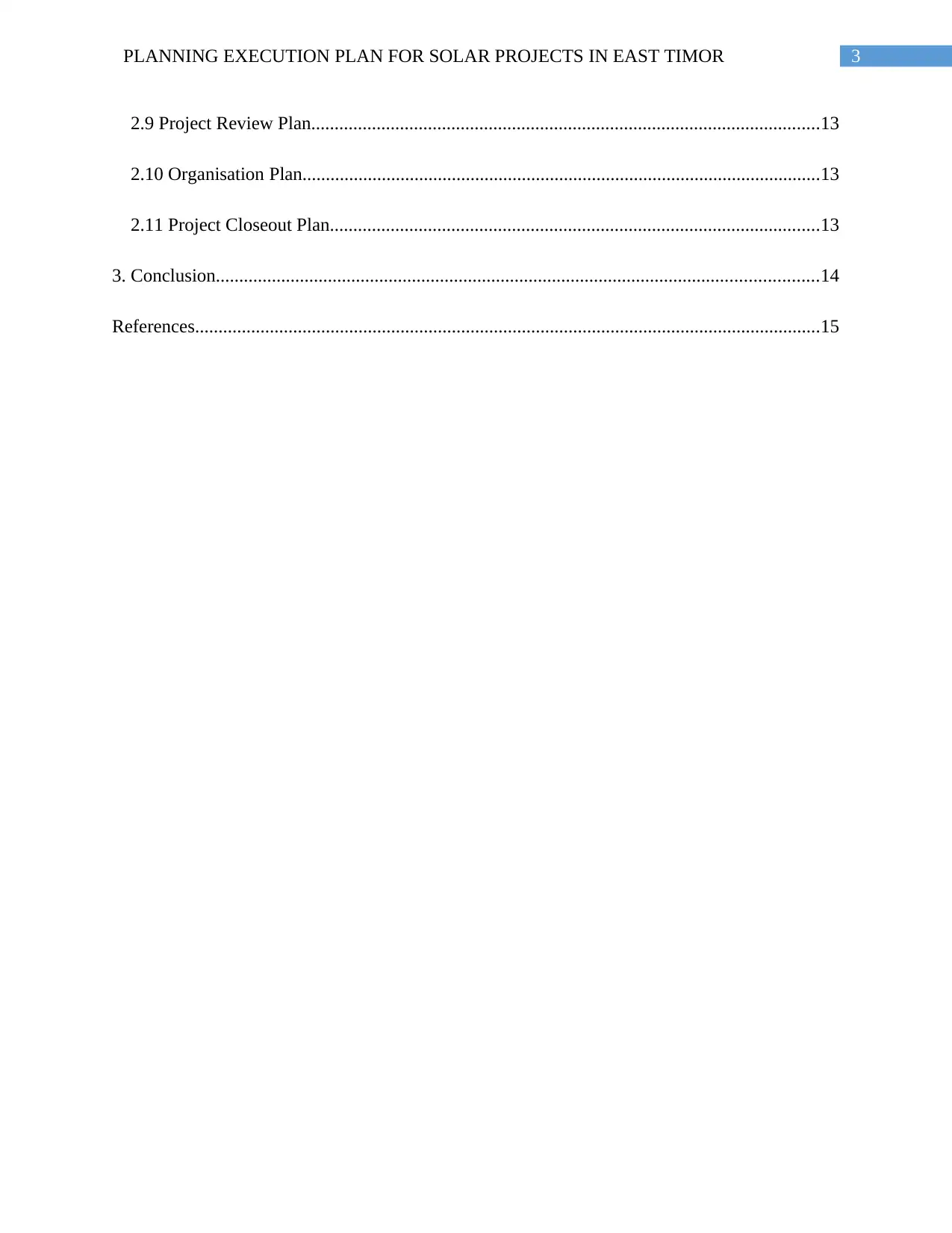
3PLANNING EXECUTION PLAN FOR SOLAR PROJECTS IN EAST TIMOR
2.9 Project Review Plan.............................................................................................................13
2.10 Organisation Plan...............................................................................................................13
2.11 Project Closeout Plan.........................................................................................................13
3. Conclusion.................................................................................................................................14
References......................................................................................................................................15
2.9 Project Review Plan.............................................................................................................13
2.10 Organisation Plan...............................................................................................................13
2.11 Project Closeout Plan.........................................................................................................13
3. Conclusion.................................................................................................................................14
References......................................................................................................................................15
Paraphrase This Document
Need a fresh take? Get an instant paraphrase of this document with our AI Paraphraser
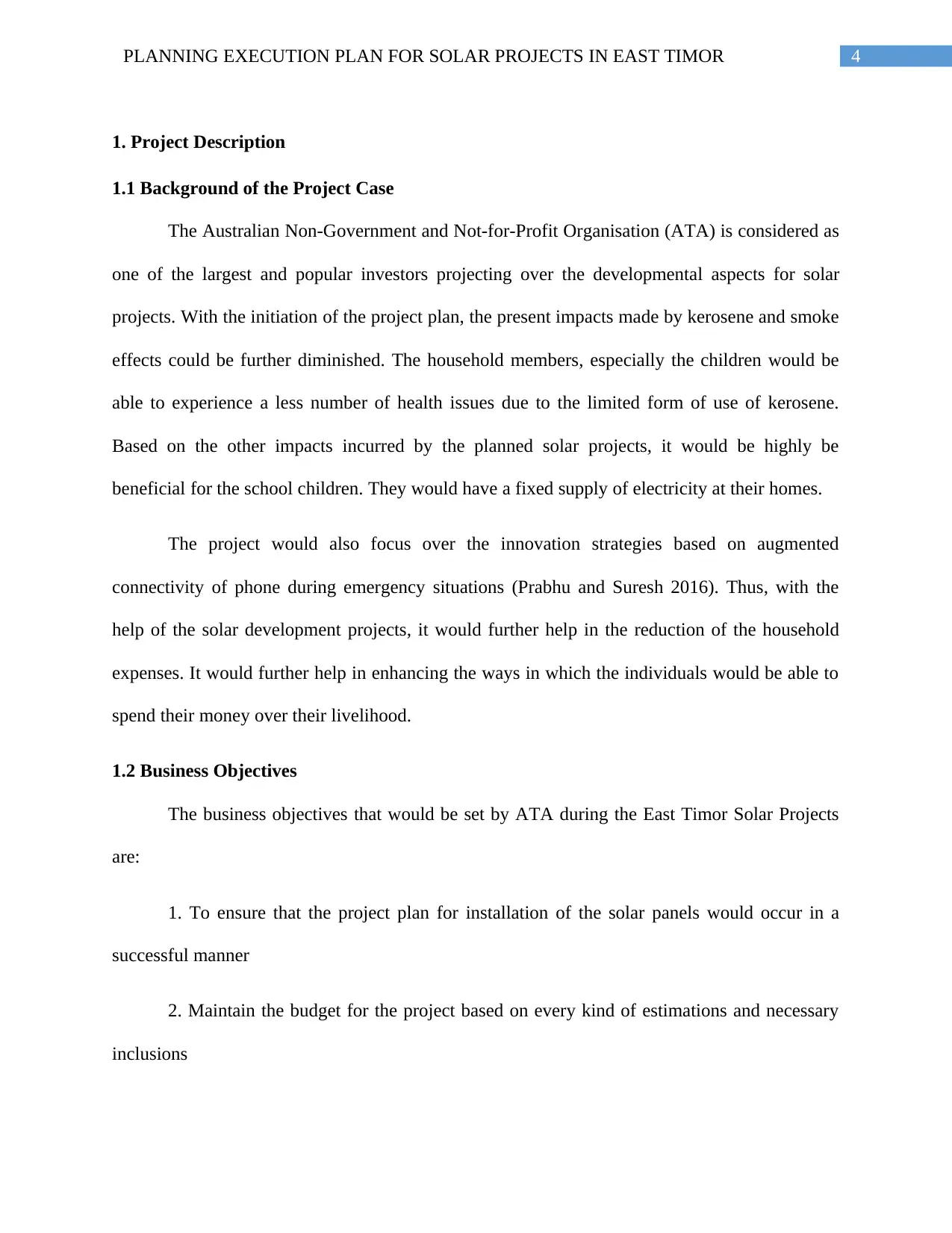
4PLANNING EXECUTION PLAN FOR SOLAR PROJECTS IN EAST TIMOR
1. Project Description
1.1 Background of the Project Case
The Australian Non-Government and Not-for-Profit Organisation (ATA) is considered as
one of the largest and popular investors projecting over the developmental aspects for solar
projects. With the initiation of the project plan, the present impacts made by kerosene and smoke
effects could be further diminished. The household members, especially the children would be
able to experience a less number of health issues due to the limited form of use of kerosene.
Based on the other impacts incurred by the planned solar projects, it would be highly be
beneficial for the school children. They would have a fixed supply of electricity at their homes.
The project would also focus over the innovation strategies based on augmented
connectivity of phone during emergency situations (Prabhu and Suresh 2016). Thus, with the
help of the solar development projects, it would further help in the reduction of the household
expenses. It would further help in enhancing the ways in which the individuals would be able to
spend their money over their livelihood.
1.2 Business Objectives
The business objectives that would be set by ATA during the East Timor Solar Projects
are:
1. To ensure that the project plan for installation of the solar panels would occur in a
successful manner
2. Maintain the budget for the project based on every kind of estimations and necessary
inclusions
1. Project Description
1.1 Background of the Project Case
The Australian Non-Government and Not-for-Profit Organisation (ATA) is considered as
one of the largest and popular investors projecting over the developmental aspects for solar
projects. With the initiation of the project plan, the present impacts made by kerosene and smoke
effects could be further diminished. The household members, especially the children would be
able to experience a less number of health issues due to the limited form of use of kerosene.
Based on the other impacts incurred by the planned solar projects, it would be highly be
beneficial for the school children. They would have a fixed supply of electricity at their homes.
The project would also focus over the innovation strategies based on augmented
connectivity of phone during emergency situations (Prabhu and Suresh 2016). Thus, with the
help of the solar development projects, it would further help in the reduction of the household
expenses. It would further help in enhancing the ways in which the individuals would be able to
spend their money over their livelihood.
1.2 Business Objectives
The business objectives that would be set by ATA during the East Timor Solar Projects
are:
1. To ensure that the project plan for installation of the solar panels would occur in a
successful manner
2. Maintain the budget for the project based on every kind of estimations and necessary
inclusions
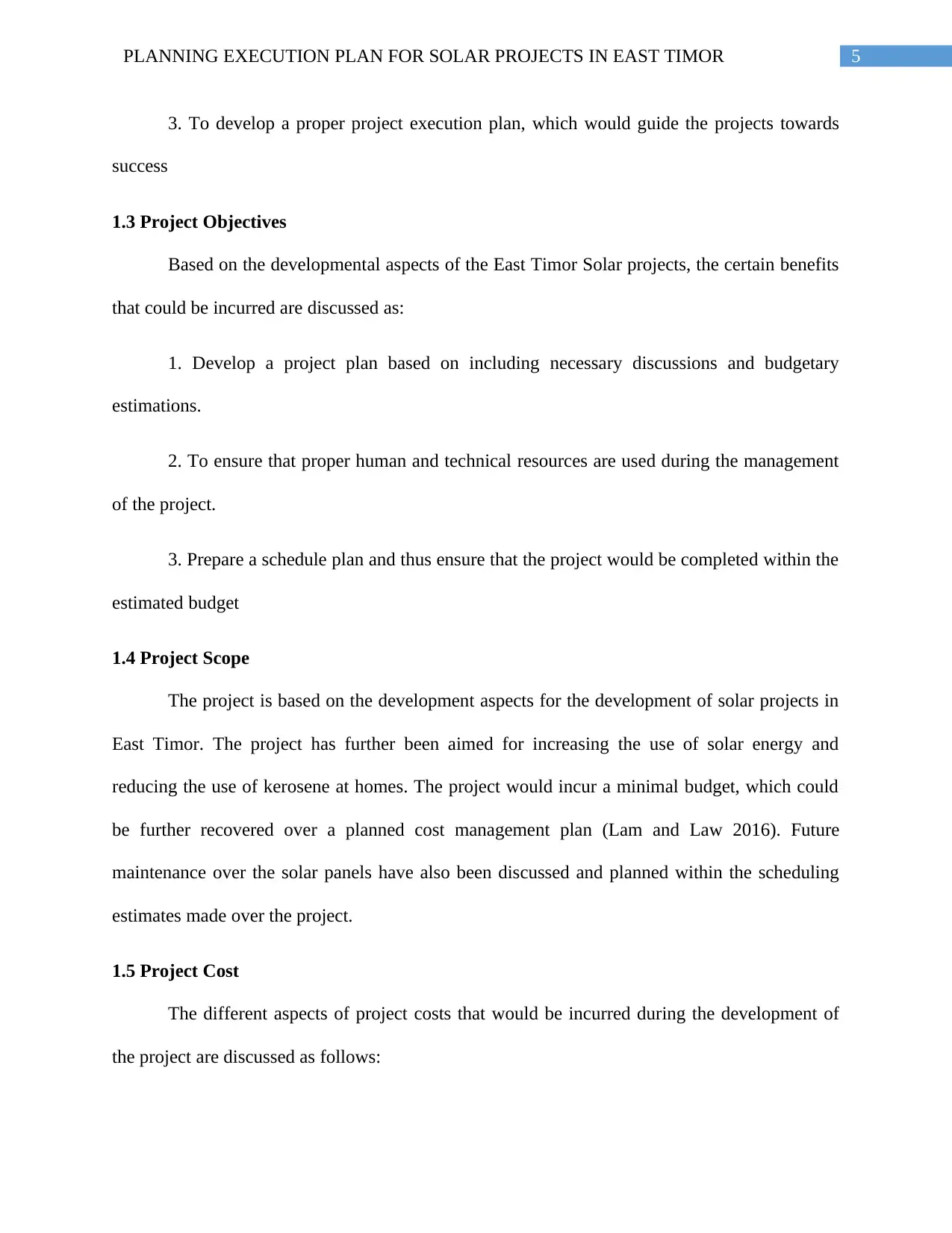
5PLANNING EXECUTION PLAN FOR SOLAR PROJECTS IN EAST TIMOR
3. To develop a proper project execution plan, which would guide the projects towards
success
1.3 Project Objectives
Based on the developmental aspects of the East Timor Solar projects, the certain benefits
that could be incurred are discussed as:
1. Develop a project plan based on including necessary discussions and budgetary
estimations.
2. To ensure that proper human and technical resources are used during the management
of the project.
3. Prepare a schedule plan and thus ensure that the project would be completed within the
estimated budget
1.4 Project Scope
The project is based on the development aspects for the development of solar projects in
East Timor. The project has further been aimed for increasing the use of solar energy and
reducing the use of kerosene at homes. The project would incur a minimal budget, which could
be further recovered over a planned cost management plan (Lam and Law 2016). Future
maintenance over the solar panels have also been discussed and planned within the scheduling
estimates made over the project.
1.5 Project Cost
The different aspects of project costs that would be incurred during the development of
the project are discussed as follows:
3. To develop a proper project execution plan, which would guide the projects towards
success
1.3 Project Objectives
Based on the developmental aspects of the East Timor Solar projects, the certain benefits
that could be incurred are discussed as:
1. Develop a project plan based on including necessary discussions and budgetary
estimations.
2. To ensure that proper human and technical resources are used during the management
of the project.
3. Prepare a schedule plan and thus ensure that the project would be completed within the
estimated budget
1.4 Project Scope
The project is based on the development aspects for the development of solar projects in
East Timor. The project has further been aimed for increasing the use of solar energy and
reducing the use of kerosene at homes. The project would incur a minimal budget, which could
be further recovered over a planned cost management plan (Lam and Law 2016). Future
maintenance over the solar panels have also been discussed and planned within the scheduling
estimates made over the project.
1.5 Project Cost
The different aspects of project costs that would be incurred during the development of
the project are discussed as follows:
⊘ This is a preview!⊘
Do you want full access?
Subscribe today to unlock all pages.

Trusted by 1+ million students worldwide
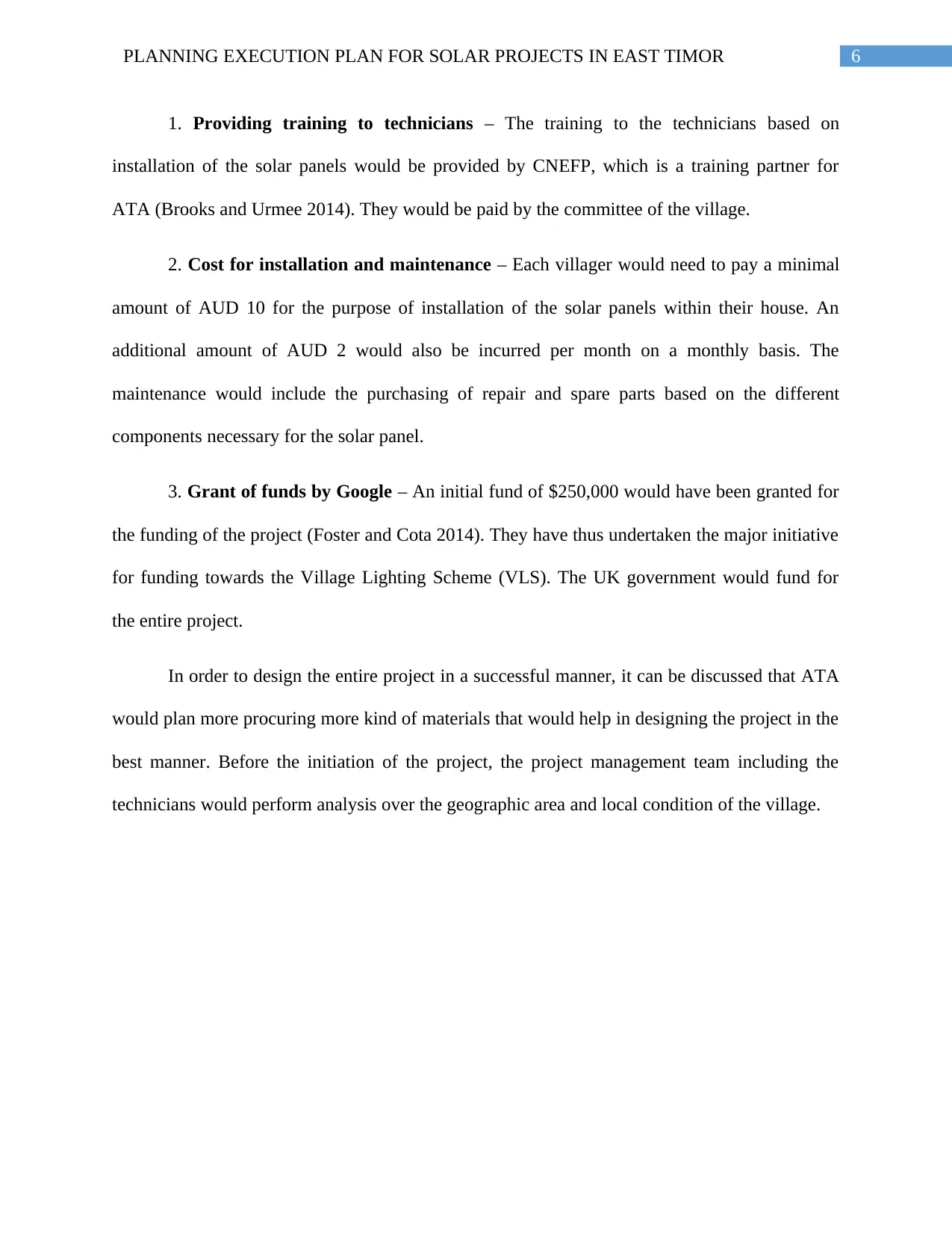
6PLANNING EXECUTION PLAN FOR SOLAR PROJECTS IN EAST TIMOR
1. Providing training to technicians – The training to the technicians based on
installation of the solar panels would be provided by CNEFP, which is a training partner for
ATA (Brooks and Urmee 2014). They would be paid by the committee of the village.
2. Cost for installation and maintenance – Each villager would need to pay a minimal
amount of AUD 10 for the purpose of installation of the solar panels within their house. An
additional amount of AUD 2 would also be incurred per month on a monthly basis. The
maintenance would include the purchasing of repair and spare parts based on the different
components necessary for the solar panel.
3. Grant of funds by Google – An initial fund of $250,000 would have been granted for
the funding of the project (Foster and Cota 2014). They have thus undertaken the major initiative
for funding towards the Village Lighting Scheme (VLS). The UK government would fund for
the entire project.
In order to design the entire project in a successful manner, it can be discussed that ATA
would plan more procuring more kind of materials that would help in designing the project in the
best manner. Before the initiation of the project, the project management team including the
technicians would perform analysis over the geographic area and local condition of the village.
1. Providing training to technicians – The training to the technicians based on
installation of the solar panels would be provided by CNEFP, which is a training partner for
ATA (Brooks and Urmee 2014). They would be paid by the committee of the village.
2. Cost for installation and maintenance – Each villager would need to pay a minimal
amount of AUD 10 for the purpose of installation of the solar panels within their house. An
additional amount of AUD 2 would also be incurred per month on a monthly basis. The
maintenance would include the purchasing of repair and spare parts based on the different
components necessary for the solar panel.
3. Grant of funds by Google – An initial fund of $250,000 would have been granted for
the funding of the project (Foster and Cota 2014). They have thus undertaken the major initiative
for funding towards the Village Lighting Scheme (VLS). The UK government would fund for
the entire project.
In order to design the entire project in a successful manner, it can be discussed that ATA
would plan more procuring more kind of materials that would help in designing the project in the
best manner. Before the initiation of the project, the project management team including the
technicians would perform analysis over the geographic area and local condition of the village.
Paraphrase This Document
Need a fresh take? Get an instant paraphrase of this document with our AI Paraphraser
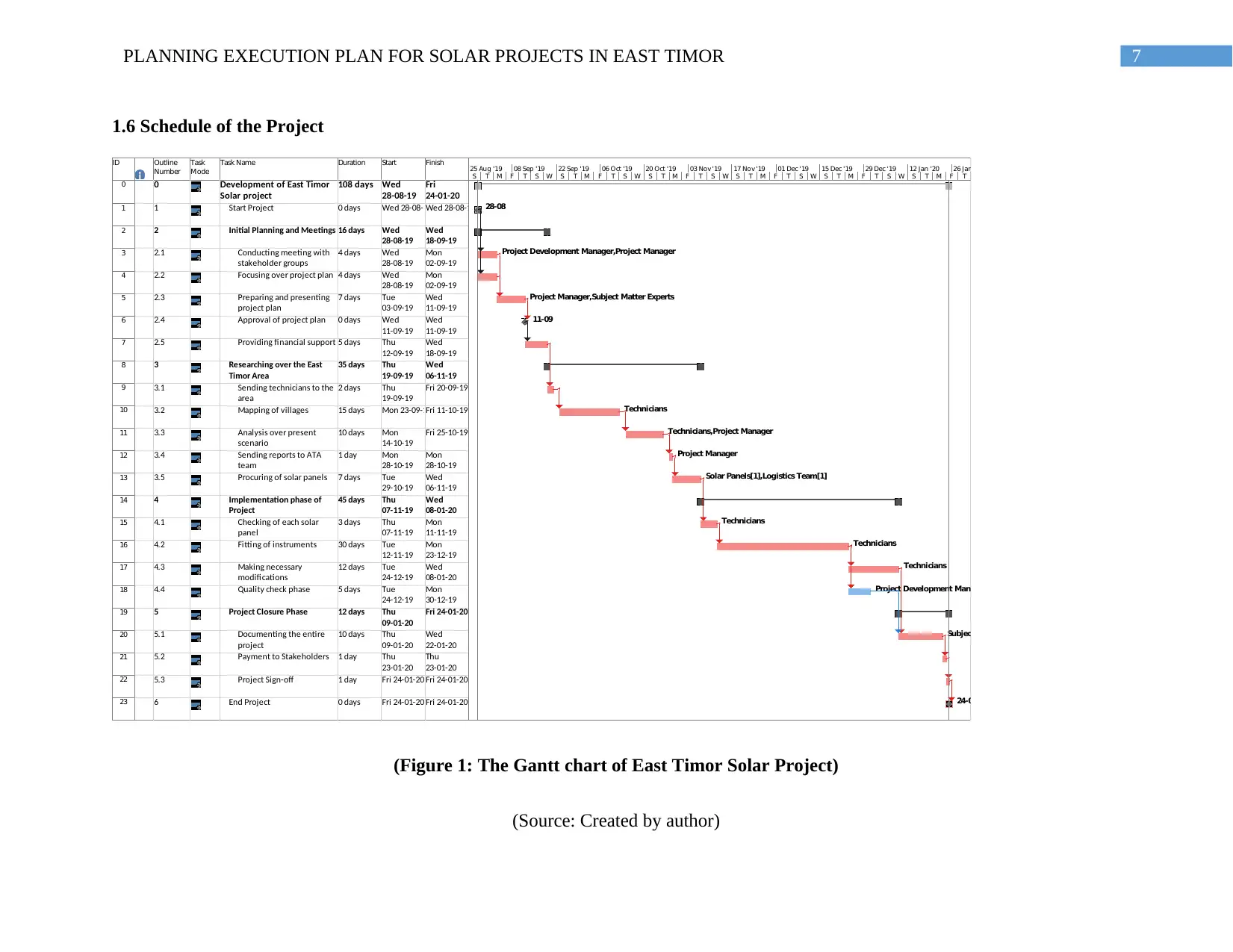
7PLANNING EXECUTION PLAN FOR SOLAR PROJECTS IN EAST TIMOR
1.6 Schedule of the Project
ID Outline
Number
Task
Mode
Task Name Duration Start Finish
0 0 Development of East Timor
Solar project
108 days Wed
28-08-19
Fri
24-01-20
1 1 Start Project 0 days Wed 28-08-19Wed 28-08-19
2 2 Initial Planning and Meetings 16 days Wed
28-08-19
Wed
18-09-19
3 2.1 Conducting meeting with
stakeholder groups
4 days Wed
28-08-19
Mon
02-09-19
4 2.2 Focusing over project plan 4 days Wed
28-08-19
Mon
02-09-19
5 2.3 Preparing and presenting
project plan
7 days Tue
03-09-19
Wed
11-09-19
6 2.4 Approval of project plan 0 days Wed
11-09-19
Wed
11-09-19
7 2.5 Providing financial support 5 days Thu
12-09-19
Wed
18-09-19
8 3 Researching over the East
Timor Area
35 days Thu
19-09-19
Wed
06-11-19
9 3.1 Sending technicians to the
area
2 days Thu
19-09-19
Fri 20-09-19
10 3.2 Mapping of villages 15 days Mon 23-09-19Fri 11-10-19
11 3.3 Analysis over present
scenario
10 days Mon
14-10-19
Fri 25-10-19
12 3.4 Sending reports to ATA
team
1 day Mon
28-10-19
Mon
28-10-19
13 3.5 Procuring of solar panels 7 days Tue
29-10-19
Wed
06-11-19
14 4 Implementation phase of
Project
45 days Thu
07-11-19
Wed
08-01-20
15 4.1 Checking of each solar
panel
3 days Thu
07-11-19
Mon
11-11-19
16 4.2 Fitting of instruments 30 days Tue
12-11-19
Mon
23-12-19
17 4.3 Making necessary
modifications
12 days Tue
24-12-19
Wed
08-01-20
18 4.4 Quality check phase 5 days Tue
24-12-19
Mon
30-12-19
19 5 Project Closure Phase 12 days Thu
09-01-20
Fri 24-01-20
20 5.1 Documenting the entire
project
10 days Thu
09-01-20
Wed
22-01-20
21 5.2 Payment to Stakeholders 1 day Thu
23-01-20
Thu
23-01-20
22 5.3 Project Sign-off 1 day Fri 24-01-20 Fri 24-01-20
23 6 End Project 0 days Fri 24-01-20 Fri 24-01-20
28-08
Project Development Manager,Project Manager
Project Manager,Subject Matter Experts
11-09
Technicians
Technicians,Project Manager
Project Manager
Solar Panels[1],Logistics Team[1]
Technicians
Technicians
Technicians
Project Development Manager,Technicians
Subject Matter Experts
24-01
S T M F T S W S T M F T S W S T M F T S W S T M F T S W S T M F T S W S T M F T
25 Aug '19 08 Sep '19 22 Sep '19 06 Oct '19 20 Oct '19 03 Nov '19 17 Nov '19 01 Dec '19 15 Dec '19 29 Dec '19 12 Jan '20 26 Jan '20
(Figure 1: The Gantt chart of East Timor Solar Project)
(Source: Created by author)
1.6 Schedule of the Project
ID Outline
Number
Task
Mode
Task Name Duration Start Finish
0 0 Development of East Timor
Solar project
108 days Wed
28-08-19
Fri
24-01-20
1 1 Start Project 0 days Wed 28-08-19Wed 28-08-19
2 2 Initial Planning and Meetings 16 days Wed
28-08-19
Wed
18-09-19
3 2.1 Conducting meeting with
stakeholder groups
4 days Wed
28-08-19
Mon
02-09-19
4 2.2 Focusing over project plan 4 days Wed
28-08-19
Mon
02-09-19
5 2.3 Preparing and presenting
project plan
7 days Tue
03-09-19
Wed
11-09-19
6 2.4 Approval of project plan 0 days Wed
11-09-19
Wed
11-09-19
7 2.5 Providing financial support 5 days Thu
12-09-19
Wed
18-09-19
8 3 Researching over the East
Timor Area
35 days Thu
19-09-19
Wed
06-11-19
9 3.1 Sending technicians to the
area
2 days Thu
19-09-19
Fri 20-09-19
10 3.2 Mapping of villages 15 days Mon 23-09-19Fri 11-10-19
11 3.3 Analysis over present
scenario
10 days Mon
14-10-19
Fri 25-10-19
12 3.4 Sending reports to ATA
team
1 day Mon
28-10-19
Mon
28-10-19
13 3.5 Procuring of solar panels 7 days Tue
29-10-19
Wed
06-11-19
14 4 Implementation phase of
Project
45 days Thu
07-11-19
Wed
08-01-20
15 4.1 Checking of each solar
panel
3 days Thu
07-11-19
Mon
11-11-19
16 4.2 Fitting of instruments 30 days Tue
12-11-19
Mon
23-12-19
17 4.3 Making necessary
modifications
12 days Tue
24-12-19
Wed
08-01-20
18 4.4 Quality check phase 5 days Tue
24-12-19
Mon
30-12-19
19 5 Project Closure Phase 12 days Thu
09-01-20
Fri 24-01-20
20 5.1 Documenting the entire
project
10 days Thu
09-01-20
Wed
22-01-20
21 5.2 Payment to Stakeholders 1 day Thu
23-01-20
Thu
23-01-20
22 5.3 Project Sign-off 1 day Fri 24-01-20 Fri 24-01-20
23 6 End Project 0 days Fri 24-01-20 Fri 24-01-20
28-08
Project Development Manager,Project Manager
Project Manager,Subject Matter Experts
11-09
Technicians
Technicians,Project Manager
Project Manager
Solar Panels[1],Logistics Team[1]
Technicians
Technicians
Technicians
Project Development Manager,Technicians
Subject Matter Experts
24-01
S T M F T S W S T M F T S W S T M F T S W S T M F T S W S T M F T S W S T M F T
25 Aug '19 08 Sep '19 22 Sep '19 06 Oct '19 20 Oct '19 03 Nov '19 17 Nov '19 01 Dec '19 15 Dec '19 29 Dec '19 12 Jan '20 26 Jan '20
(Figure 1: The Gantt chart of East Timor Solar Project)
(Source: Created by author)
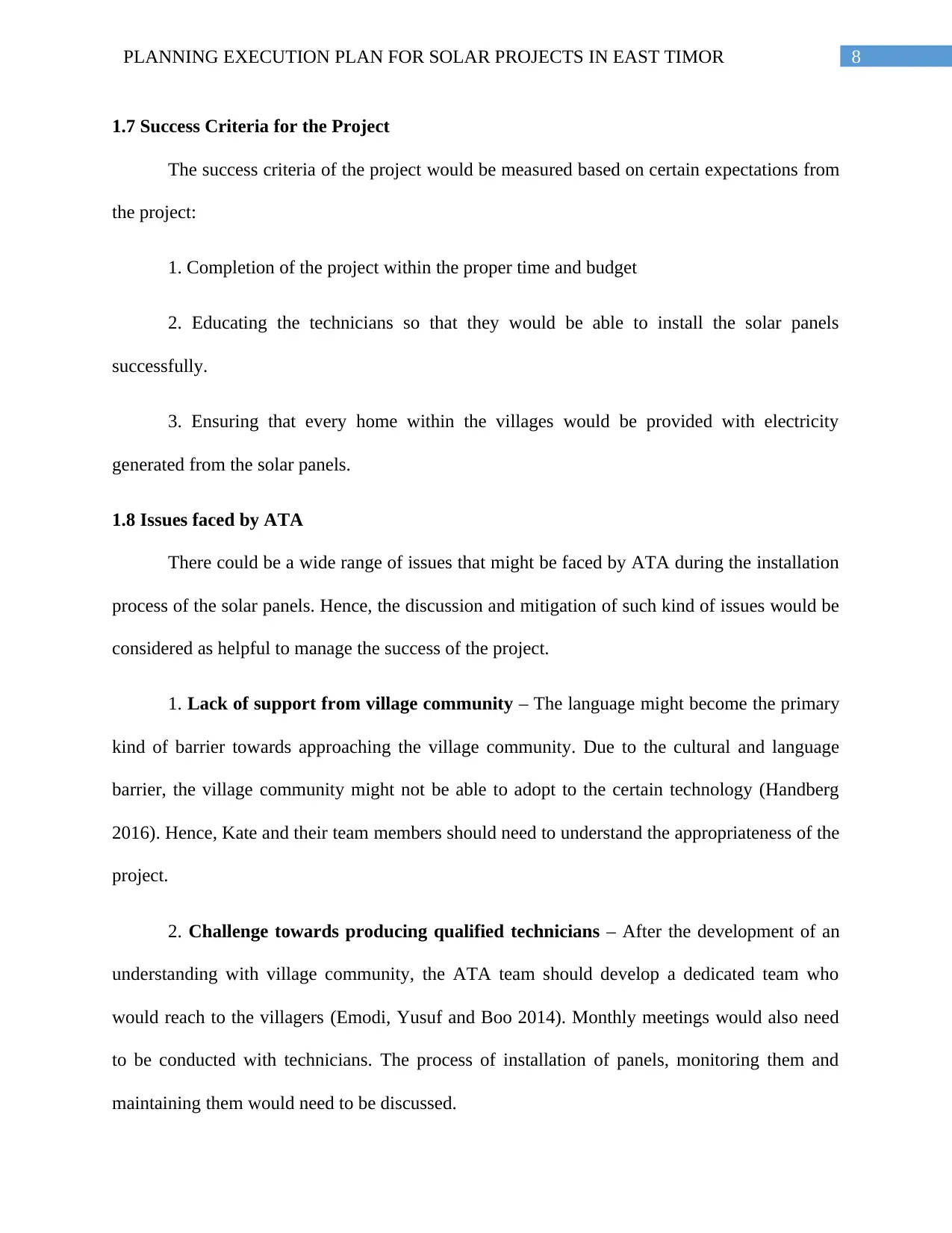
8PLANNING EXECUTION PLAN FOR SOLAR PROJECTS IN EAST TIMOR
1.7 Success Criteria for the Project
The success criteria of the project would be measured based on certain expectations from
the project:
1. Completion of the project within the proper time and budget
2. Educating the technicians so that they would be able to install the solar panels
successfully.
3. Ensuring that every home within the villages would be provided with electricity
generated from the solar panels.
1.8 Issues faced by ATA
There could be a wide range of issues that might be faced by ATA during the installation
process of the solar panels. Hence, the discussion and mitigation of such kind of issues would be
considered as helpful to manage the success of the project.
1. Lack of support from village community – The language might become the primary
kind of barrier towards approaching the village community. Due to the cultural and language
barrier, the village community might not be able to adopt to the certain technology (Handberg
2016). Hence, Kate and their team members should need to understand the appropriateness of the
project.
2. Challenge towards producing qualified technicians – After the development of an
understanding with village community, the ATA team should develop a dedicated team who
would reach to the villagers (Emodi, Yusuf and Boo 2014). Monthly meetings would also need
to be conducted with technicians. The process of installation of panels, monitoring them and
maintaining them would need to be discussed.
1.7 Success Criteria for the Project
The success criteria of the project would be measured based on certain expectations from
the project:
1. Completion of the project within the proper time and budget
2. Educating the technicians so that they would be able to install the solar panels
successfully.
3. Ensuring that every home within the villages would be provided with electricity
generated from the solar panels.
1.8 Issues faced by ATA
There could be a wide range of issues that might be faced by ATA during the installation
process of the solar panels. Hence, the discussion and mitigation of such kind of issues would be
considered as helpful to manage the success of the project.
1. Lack of support from village community – The language might become the primary
kind of barrier towards approaching the village community. Due to the cultural and language
barrier, the village community might not be able to adopt to the certain technology (Handberg
2016). Hence, Kate and their team members should need to understand the appropriateness of the
project.
2. Challenge towards producing qualified technicians – After the development of an
understanding with village community, the ATA team should develop a dedicated team who
would reach to the villagers (Emodi, Yusuf and Boo 2014). Monthly meetings would also need
to be conducted with technicians. The process of installation of panels, monitoring them and
maintaining them would need to be discussed.
⊘ This is a preview!⊘
Do you want full access?
Subscribe today to unlock all pages.

Trusted by 1+ million students worldwide
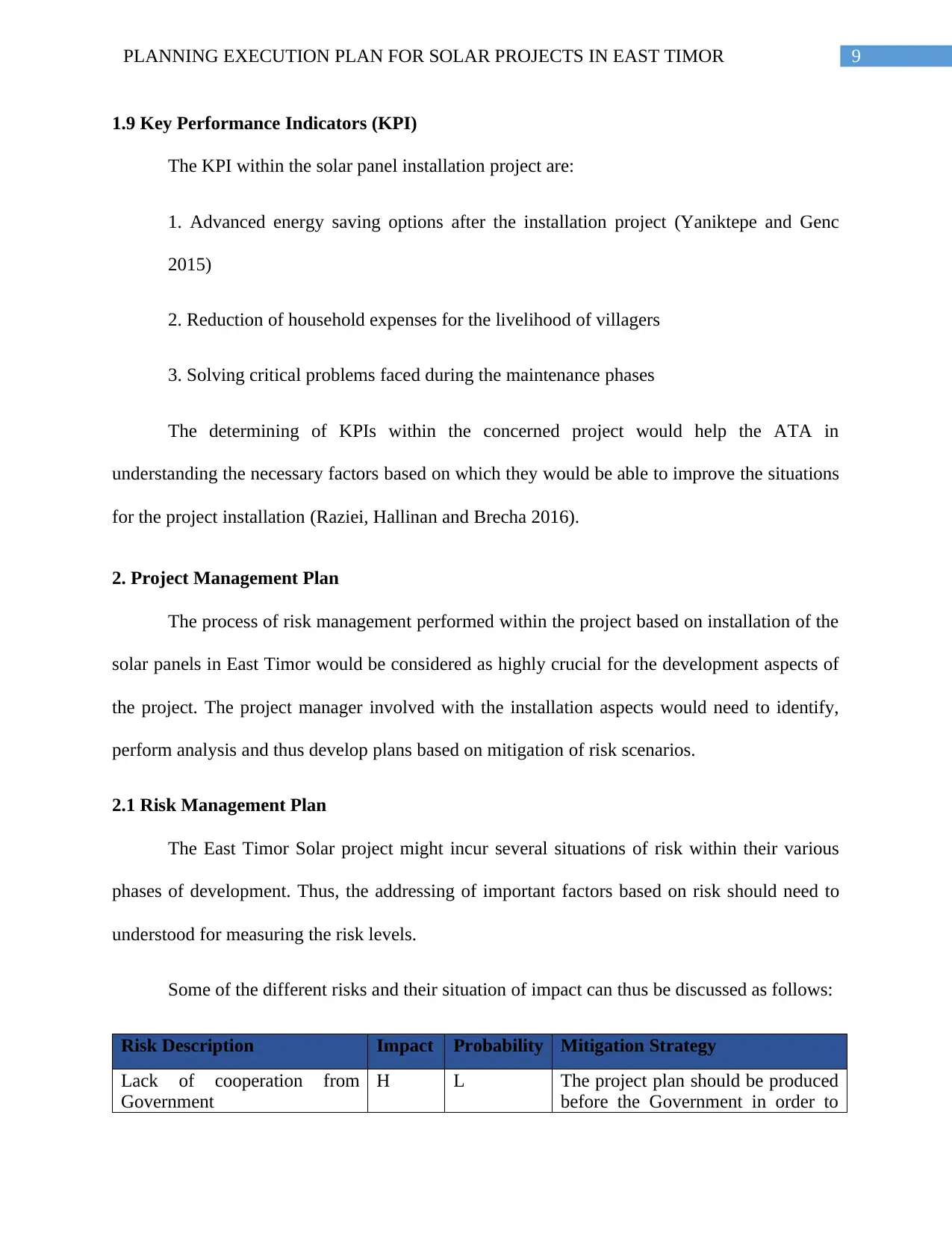
9PLANNING EXECUTION PLAN FOR SOLAR PROJECTS IN EAST TIMOR
1.9 Key Performance Indicators (KPI)
The KPI within the solar panel installation project are:
1. Advanced energy saving options after the installation project (Yaniktepe and Genc
2015)
2. Reduction of household expenses for the livelihood of villagers
3. Solving critical problems faced during the maintenance phases
The determining of KPIs within the concerned project would help the ATA in
understanding the necessary factors based on which they would be able to improve the situations
for the project installation (Raziei, Hallinan and Brecha 2016).
2. Project Management Plan
The process of risk management performed within the project based on installation of the
solar panels in East Timor would be considered as highly crucial for the development aspects of
the project. The project manager involved with the installation aspects would need to identify,
perform analysis and thus develop plans based on mitigation of risk scenarios.
2.1 Risk Management Plan
The East Timor Solar project might incur several situations of risk within their various
phases of development. Thus, the addressing of important factors based on risk should need to
understood for measuring the risk levels.
Some of the different risks and their situation of impact can thus be discussed as follows:
Risk Description Impact Probability Mitigation Strategy
Lack of cooperation from
Government
H L The project plan should be produced
before the Government in order to
1.9 Key Performance Indicators (KPI)
The KPI within the solar panel installation project are:
1. Advanced energy saving options after the installation project (Yaniktepe and Genc
2015)
2. Reduction of household expenses for the livelihood of villagers
3. Solving critical problems faced during the maintenance phases
The determining of KPIs within the concerned project would help the ATA in
understanding the necessary factors based on which they would be able to improve the situations
for the project installation (Raziei, Hallinan and Brecha 2016).
2. Project Management Plan
The process of risk management performed within the project based on installation of the
solar panels in East Timor would be considered as highly crucial for the development aspects of
the project. The project manager involved with the installation aspects would need to identify,
perform analysis and thus develop plans based on mitigation of risk scenarios.
2.1 Risk Management Plan
The East Timor Solar project might incur several situations of risk within their various
phases of development. Thus, the addressing of important factors based on risk should need to
understood for measuring the risk levels.
Some of the different risks and their situation of impact can thus be discussed as follows:
Risk Description Impact Probability Mitigation Strategy
Lack of cooperation from
Government
H L The project plan should be produced
before the Government in order to
Paraphrase This Document
Need a fresh take? Get an instant paraphrase of this document with our AI Paraphraser
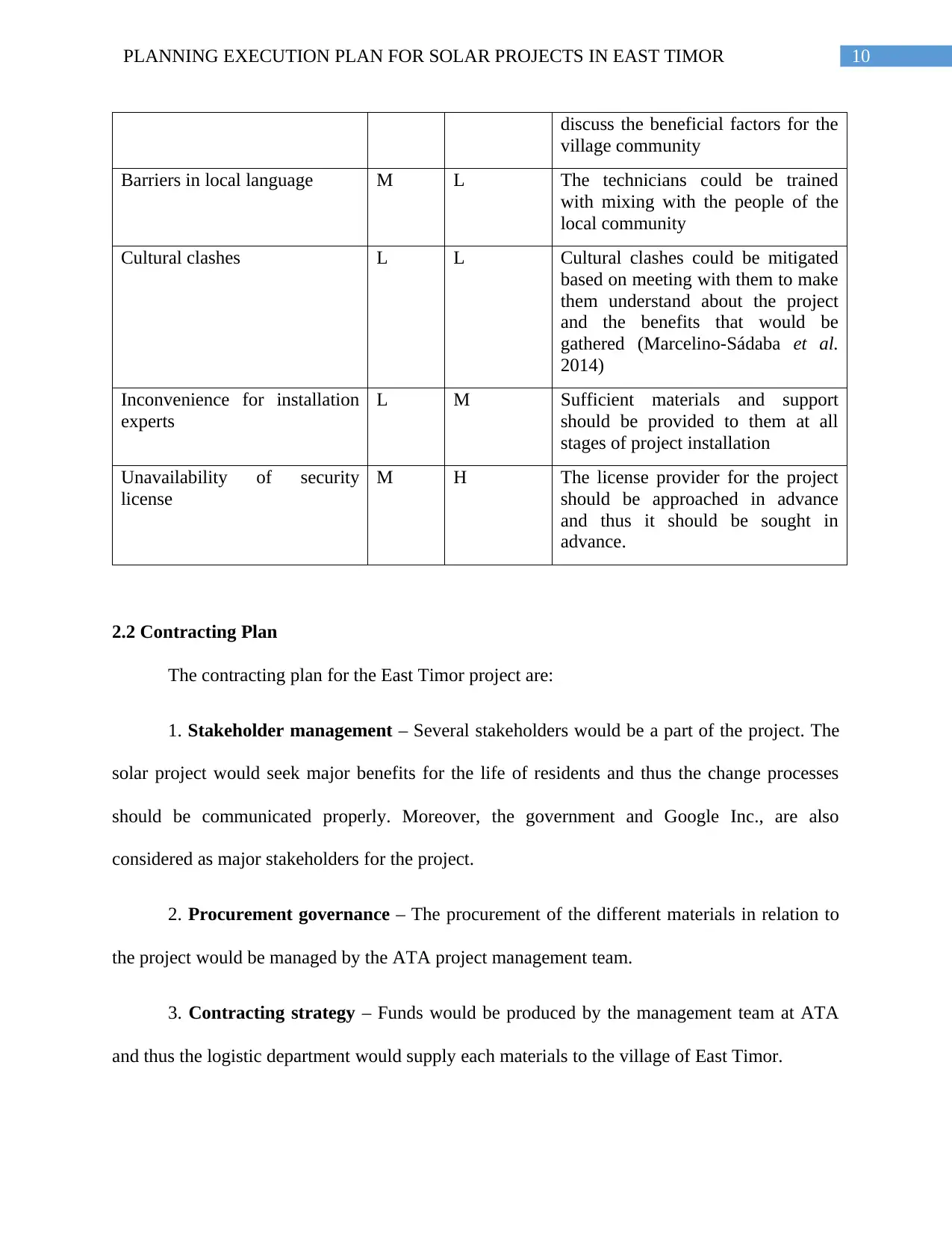
10PLANNING EXECUTION PLAN FOR SOLAR PROJECTS IN EAST TIMOR
discuss the beneficial factors for the
village community
Barriers in local language M L The technicians could be trained
with mixing with the people of the
local community
Cultural clashes L L Cultural clashes could be mitigated
based on meeting with them to make
them understand about the project
and the benefits that would be
gathered (Marcelino-Sádaba et al.
2014)
Inconvenience for installation
experts
L M Sufficient materials and support
should be provided to them at all
stages of project installation
Unavailability of security
license
M H The license provider for the project
should be approached in advance
and thus it should be sought in
advance.
2.2 Contracting Plan
The contracting plan for the East Timor project are:
1. Stakeholder management – Several stakeholders would be a part of the project. The
solar project would seek major benefits for the life of residents and thus the change processes
should be communicated properly. Moreover, the government and Google Inc., are also
considered as major stakeholders for the project.
2. Procurement governance – The procurement of the different materials in relation to
the project would be managed by the ATA project management team.
3. Contracting strategy – Funds would be produced by the management team at ATA
and thus the logistic department would supply each materials to the village of East Timor.
discuss the beneficial factors for the
village community
Barriers in local language M L The technicians could be trained
with mixing with the people of the
local community
Cultural clashes L L Cultural clashes could be mitigated
based on meeting with them to make
them understand about the project
and the benefits that would be
gathered (Marcelino-Sádaba et al.
2014)
Inconvenience for installation
experts
L M Sufficient materials and support
should be provided to them at all
stages of project installation
Unavailability of security
license
M H The license provider for the project
should be approached in advance
and thus it should be sought in
advance.
2.2 Contracting Plan
The contracting plan for the East Timor project are:
1. Stakeholder management – Several stakeholders would be a part of the project. The
solar project would seek major benefits for the life of residents and thus the change processes
should be communicated properly. Moreover, the government and Google Inc., are also
considered as major stakeholders for the project.
2. Procurement governance – The procurement of the different materials in relation to
the project would be managed by the ATA project management team.
3. Contracting strategy – Funds would be produced by the management team at ATA
and thus the logistic department would supply each materials to the village of East Timor.
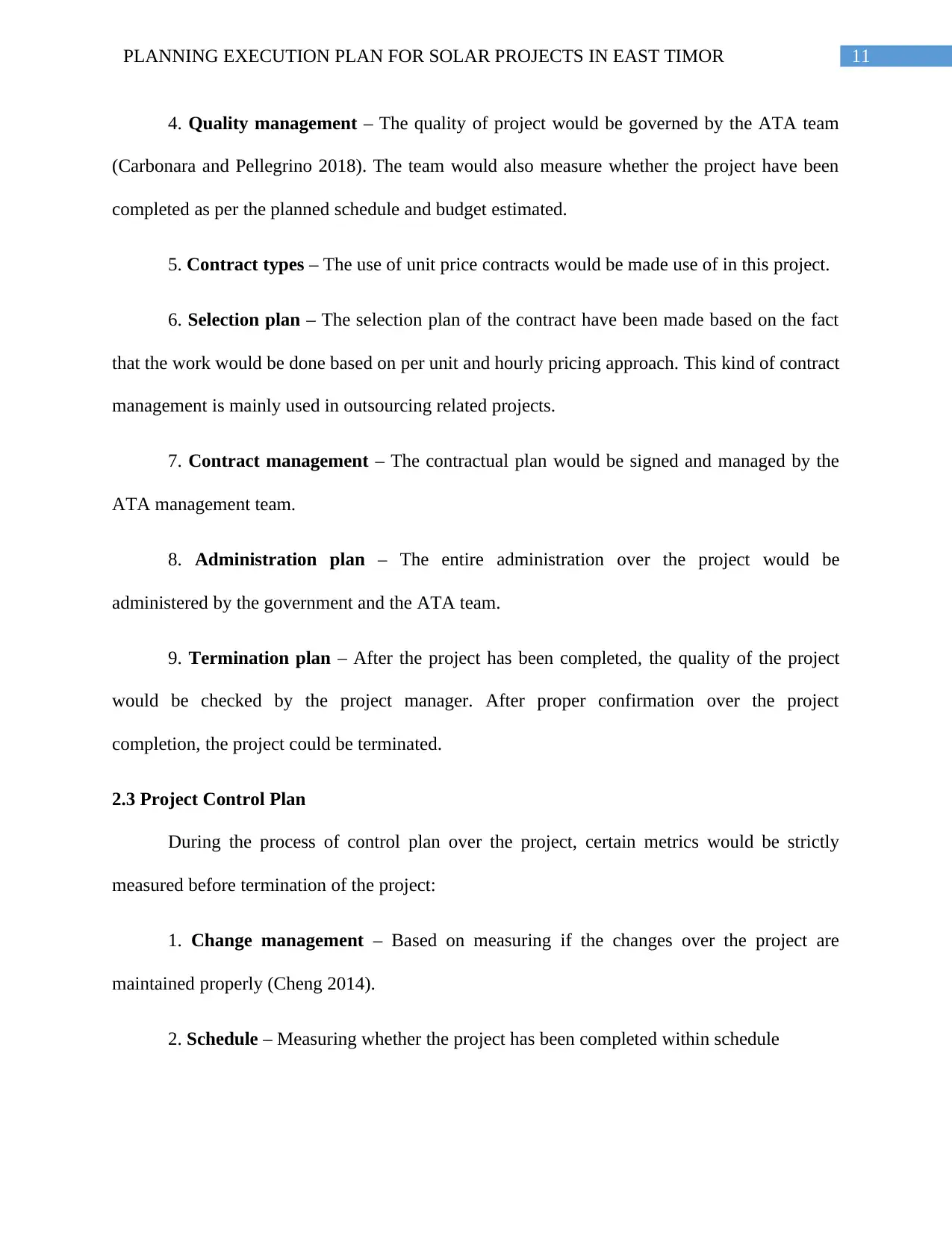
11PLANNING EXECUTION PLAN FOR SOLAR PROJECTS IN EAST TIMOR
4. Quality management – The quality of project would be governed by the ATA team
(Carbonara and Pellegrino 2018). The team would also measure whether the project have been
completed as per the planned schedule and budget estimated.
5. Contract types – The use of unit price contracts would be made use of in this project.
6. Selection plan – The selection plan of the contract have been made based on the fact
that the work would be done based on per unit and hourly pricing approach. This kind of contract
management is mainly used in outsourcing related projects.
7. Contract management – The contractual plan would be signed and managed by the
ATA management team.
8. Administration plan – The entire administration over the project would be
administered by the government and the ATA team.
9. Termination plan – After the project has been completed, the quality of the project
would be checked by the project manager. After proper confirmation over the project
completion, the project could be terminated.
2.3 Project Control Plan
During the process of control plan over the project, certain metrics would be strictly
measured before termination of the project:
1. Change management – Based on measuring if the changes over the project are
maintained properly (Cheng 2014).
2. Schedule – Measuring whether the project has been completed within schedule
4. Quality management – The quality of project would be governed by the ATA team
(Carbonara and Pellegrino 2018). The team would also measure whether the project have been
completed as per the planned schedule and budget estimated.
5. Contract types – The use of unit price contracts would be made use of in this project.
6. Selection plan – The selection plan of the contract have been made based on the fact
that the work would be done based on per unit and hourly pricing approach. This kind of contract
management is mainly used in outsourcing related projects.
7. Contract management – The contractual plan would be signed and managed by the
ATA management team.
8. Administration plan – The entire administration over the project would be
administered by the government and the ATA team.
9. Termination plan – After the project has been completed, the quality of the project
would be checked by the project manager. After proper confirmation over the project
completion, the project could be terminated.
2.3 Project Control Plan
During the process of control plan over the project, certain metrics would be strictly
measured before termination of the project:
1. Change management – Based on measuring if the changes over the project are
maintained properly (Cheng 2014).
2. Schedule – Measuring whether the project has been completed within schedule
⊘ This is a preview!⊘
Do you want full access?
Subscribe today to unlock all pages.

Trusted by 1+ million students worldwide
1 out of 18
Related Documents
Your All-in-One AI-Powered Toolkit for Academic Success.
+13062052269
info@desklib.com
Available 24*7 on WhatsApp / Email
![[object Object]](/_next/static/media/star-bottom.7253800d.svg)
Unlock your academic potential
Copyright © 2020–2025 A2Z Services. All Rights Reserved. Developed and managed by ZUCOL.





